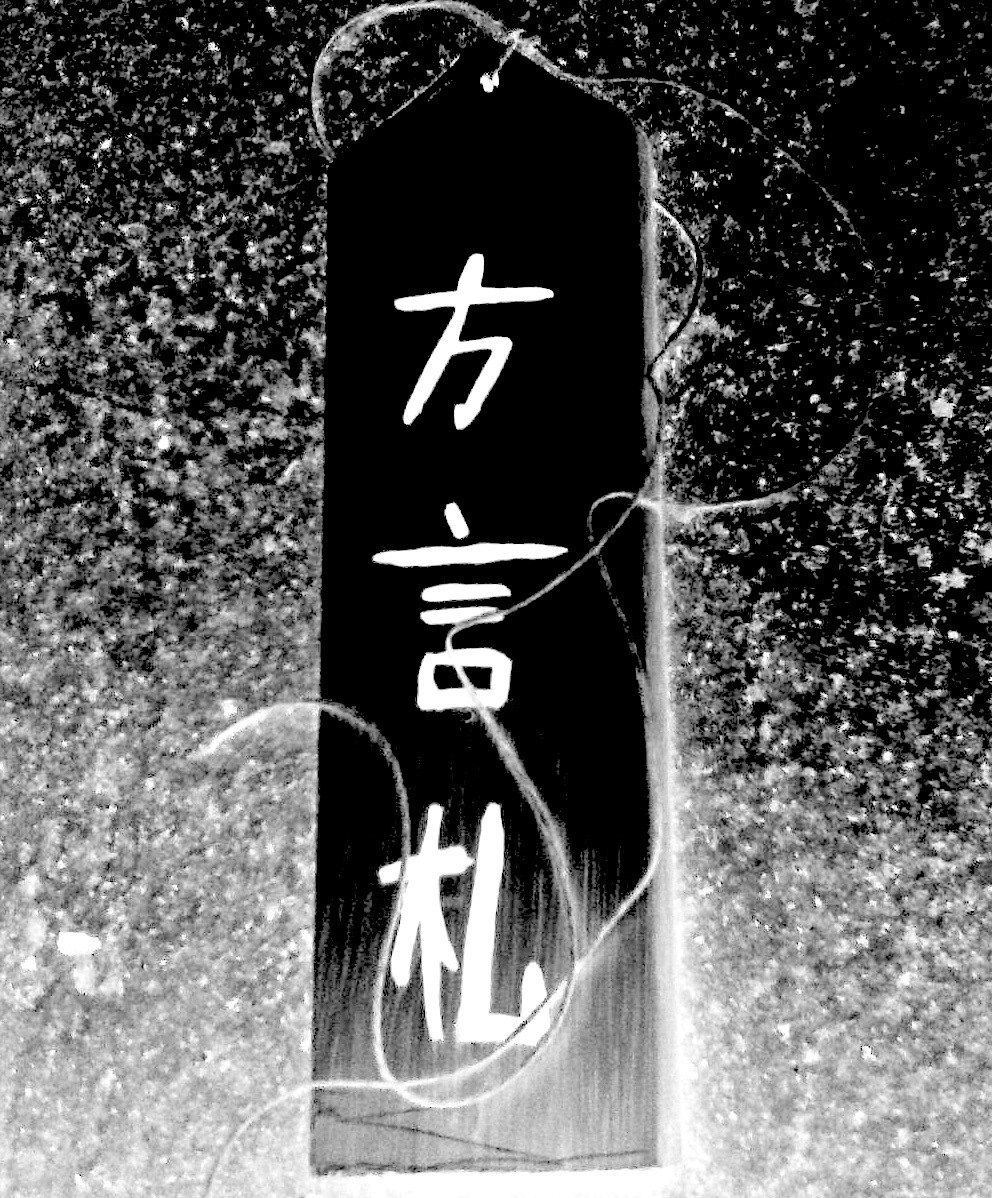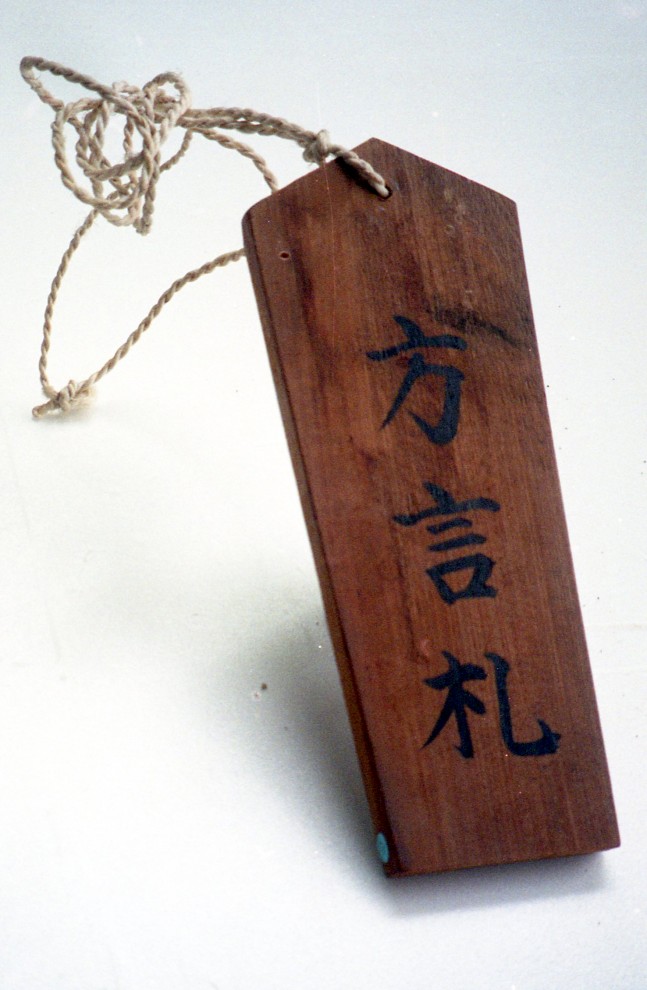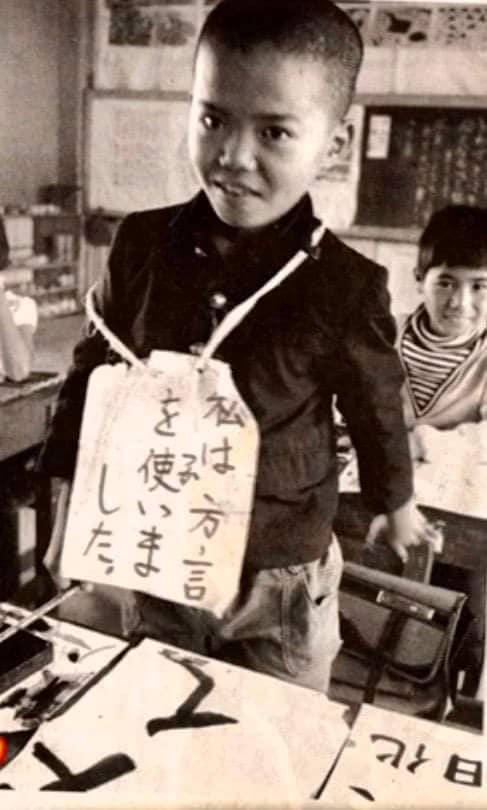方言札という言語的暴力について
Penalty by hanging Dialect card in
Modern Japan

方言札という言語的暴力について
Penalty by hanging Dialect card in
Modern Japan

A dialect card (Japanese: 方言札, Hepburn: hōgen fuda) was a system of punishment used in Japanese regional schools in the post-Meiji period to promote standard speech. It was modelled after similar policies in Europe, particularly the French Vergonha or the Welsh Not.
方言札(異言語排除私刑札)はすべての言語教育者が 戒めなければならない歴史の教訓。授業の開始前の倫理的不正の歴史的暗部。知らない教師こそ恥じるべき!!! https://bit.ly/3dyyt3W
| A dialect card
(Japanese: 方言札, Hepburn: hōgen fuda) was a type of card used in a
punishment system of Japanese regional schools in the post-Meiji period
to promote the Tokyo dialect of Japanese in favor of other Japanese
dialects and other Japonic languages. A student who spoke in dialect
would be forced to wear the card until another student also spoke in
dialect, and then it would pass to the new transgressor; the student
wearing it at the end of the school day receives corporal punishment by
the teachers.[1][2] |
方言札(ほうげんふだ)とは、明治以降の日本の地方学校において、東京
方言を奨励し、他の方言や他の日本語を奨励するために用いられた罰札の一種である。方言を話す生徒は、他の生徒も方言を話すようになるまで強制的にその
カードを付けさせられ、その後、新たな違反者にそのカードが渡る。 |
| Background During the Edo period under the Tokugawa shogunate, most Japanese people could not travel outside of their home domain. As a result, regional Japanese dialects were relatively isolated and became increasingly distinct. After the Meiji Restoration the government, in emulation of the European nation states, sought to create a standard Japanese speech. A Tokyo dialect, specifically that of the upper-class Yamanote area, became the model for Standard Japanese, widely used in schools, publishing, and radio broadcasting. By the early twentieth century, the Ministry of Education and other authorities instituted various policies to reduce or suppress regional differences.[3] |
背景 江戸時代、徳川幕府のもとでは、ほとんどの日本人は藩の外に出ることができなかった。その結果、日本の地方の方言は比較的孤立し、次第に区別されるように なった。明治維新後、政府はヨーロッパの国民国家に倣い、標準語を作ろうとした。東京の方言、特に上流階級の山の手の方言が標準語のモデルとなり、学校、 出版、ラジオ放送などで広く使われるようになった。20世紀初頭までに、文部省をはじめとする当局は、地域差を縮小または抑制するためのさまざまな政策を 実施した[3]。 |
| Implementation The use of hogen fuda was most prominent in the Tōhoku, Kyushu and Ryukyu Islands (including Okinawa) as they are geographically and linguistically most distant from the Tokyo dialect. The issue is most prominent in regard to Ryukyuan languages as there are groups, such as the Kariyushi Club, which advocate the languages to be officially recognised by the Japanese government as a language (and Ryukyu as a nation). In Okinawa, the card was initially voluntarily adopted by Okinawan students at the start of the 20th century, but became mandatory as assimilation policies increased following 1917. |
実装 方言札の使用は、地理的にも言語学的にも東京方言から最も離れている東北、九州、琉球(沖縄を含む)で最も顕著であった。琉球語に関しては、「かりゆしク ラブ」のような、琉球語を言語として(そして琉球を国家として)日本政府に公認することを主張する団体が存在するため、この問題は最も顕著である。沖縄で は、このカードは20世紀初頭に沖縄の学生によって自主的に採用されたが、1917年以降、同化政策が進むにつれて義務化された。 |
| Cultural Interaction In 2024, the Welsh message of 1923 Welsh Women's Peace was translated into Okinawan language from the perspective of the similarities between the Okinawan dialect card and the history of Welsh Not in Wales.[4] The Asahi Shimbun newspaper in Japan claimed that the reconstruction of the Okinawan language can be taken as a reference from the reconstruction of the Welsh language.[5] Japanese musician also created a short film inspired by the similarities between the history of Okinawan dialect card and Welsh Not in Wales.[6] |
文化交流 2024年、沖縄の方言カードとウェールズにおけるウェールズ語の歴史との類似性という観点から、1923年のウェールズ婦人平和のメッセージが沖縄語に 翻訳された[4]。 [4]日本の朝日新聞は、沖縄語の再構築はウェールズ語の再構築を参考にすることができると主張した[5]。日本のミュージシャンも、沖縄方言カードと ウェールズ語ノット・イン・ウェールズの歴史との類似点から着想を得て短編映画を制作した[6]。 |
| Codification Language planning Prestige (sociolinguistics) Usage Symbole, a similar punishment for Breton-speaking students Welsh Not, a similar punishment for Welsh-speaking students |
コード化 言語計画 プレステージ(社会言語学) 用法 Symbole、ブルトン語を話す学生に対する同様の罰 ウェルシュ・ノット(ウェールズ語を話す学生に対する同様の罰 |
| https://en.wikipedia.org/wiki/Dialect_card |
|
| 方言札(ほうげんふだ)あるいは方言罰札とは、標準語を普及させる手段として、主に学校において、非標準語(地方言語・方言)の使用者に掛けさせた札のこと。 フランスでは、オック語・プロヴァンス語・ブルトン語などの地方言語をフランス標準語に対する方言とし、方言を話した生徒に方言札を掛けさせて、見せしめ にするということが行われた[1]。またイギリスのウェールズでも、同様の例としてWelsh Notがあった [2]。 フランスの方言札制度は日本にも取り入れられ、特に日本本土との言語差が大きい沖縄県の教育現場で熱心に行われた。沖縄県での方言札の実態は、2001年 4月1日放送のNHK「日本のことば」の沖縄県特集でも紹介された。それによると、方言札はカマボコ板くらいの木札に紐を通したもので、学校で方言を話す と札を首に掛けなければならず、外すには他の生徒が方言を話すのを発見するしかなかった。しかし、方言札制度に反発する生徒によって却って校内での方言が 盛んになった例もあり、1917年(大正6年)に「方言取締令」を出した沖縄県立第一中学校長の山口沢之助をもじって「大和口 札取る毎に思うかな 方言の札はやめ沢之助」という反発歌が校門に貼られた逸話がある[3]。竹富島の喜宝院蒐集館では、竹富小学校で使用されていた方言札が展示されている。 [4] 沖縄県のほかに東北地方[3]や鹿児島県[5]でも同様の標準語教育が行われた。 日本が委任統治していたパラオの学校でも日本語の使用が強制される場面があり、校内でパラオ語を話した生徒に「私はパラオ語を話しました」と書いた札を首から下げさせる日本人教員もいたという[6]。 |
|
| https://x.gd/zJp11 |

竹富島喜宝院蒐集館所蔵の「方言札」


This photo of a Ryukyuan (native Okinawan)
child forced to wear a sign reading “I spoke in dialect” because he
spoke Okinawan…Such punishments were a common tactic Japan used to
eliminate native languages from the Okinawan islands and replace them
with national Japanese language - Japan Daily.
リンク
文献
その他の情報
Copyleft, CC, Mitzub'ixi Quq Chi'j, 1996-2099
